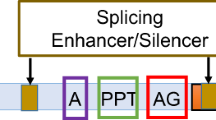Abstract
Type I Bartter syndrome (BS), an inherited salt-losing tubulopathy, is caused by mutations of the SLC12A1 gene. While several intronic nucleotide changes in this gene have been detected, transcriptional analysis had not been conducted because mRNA analysis is possible only when renal biopsy specimens can be obtained or occasionally when mRNA is expressed in the leukocytes. This report concerns a type I BS patient due to compound heterozygosity for the SLC12A1 gene. Genomic DNA sequencing disclosed the presence of two novel heterozygous mutations of c.724 + 4A > G in intron 5 and c.2095delG in intron 16, but it remains to be determined whether the former would be likely to influence the transcription. In this report, we conducted both in vivo assay of RT-PCR analysis using RNA extracted from the proband’s urinary sediments and in vitro functional splicing study by minigene construction, and obtained evidence that this intronic mutation leads to complete exon 5 skipping. To the best of our knowledge, this is the first study to use non-invasive methods for both an in vivo assay and an in vitro functional splicing assay of inherited kidney disease. These analytical assays could be adapted for all inherited kidney diseases.



Similar content being viewed by others
References
Bergmann C, Frank V, Kupper F et al (2006) Functional analysis of PKHD1 splicing in autosomal recessive polycystic kidney disease. J Hum Genet 51(9):788–793
Birkenhager R, Otto E, Schurmann MJ et al (2001) Mutation of BSND causes Bartter syndrome with sensorineural deafness and kidney failure. Nat Genet 29(3):310–314
Brochard K, Boyer O, Blanchard A, et al (2009) Phenotype–genotype correlation in antenatal and neonatal variants of Bartter syndrome. Nephrol Dial Transplant 24(5):1455–1464
Igarashi T, Inatomi J, Ohara T et al (2000) Clinical and genetic studies of CLCN5 mutations in Japanese families with Dent’s disease. Kidney Int 58(2):520–527
Iida K, Nozu K, Takahashi Y et al (2008) Characterization of a splicing abnormality in Gitelman syndrome. Am J Kidney Dis 51(6):1077–1078
Kaito H, Nozu K, Fu XJ et al (2007) Detection of a transcript abnormality in mRNA of the SLC12A3 gene extracted from urinary sediment cells of a patient with Gitelman’s syndrome. Pediatr Res 61(4):502–505
Krol RP, Nozu K, Nakanishi K et al (2008) Somatic mosaicism for a mutation of the COL4A5 gene is a cause of mild phenotype male Alport syndrome. Nephrol Dial Transplant 23(8):2525–2530
Shapiro MB, Senapathy P (1987) RNA splice junctions of different classes of eukaryotes: sequence statistics and functional implications in gene expression. Nucleic Acids Res 15(17):7155–7174
Simon DB, Karet FE, Hamdan JM et al (1996a) Bartter’s syndrome, hypokalaemic alkalosis with hypercalciuria, is caused by mutations in the Na–K–2Cl cotransporter NKCC2. Nat Genet 13(2):183–188
Simon DB, Karet FE, Rodriguez-Soriano J et al (1996b) Genetic heterogeneity of Bartter’s syndrome revealed by mutations in the K+ channel, ROMK. Nat Genet 14(2):152–156
Simon DB, Bindra RS, Mansfield TA et al (1997) Mutations in the chloride channel gene, CLCNKB, cause Bartter’s syndrome type III. Nat Genet 17(2):171–178
Takeshima Y, Nishio H, Sakamoto H et al (1995) Modulation of in vitro splicing of the upstream intron by modifying an intra-exon sequence which is deleted from the dystrophin gene in dystrophin Kobe. J Clin Invest 95(2):515–520
Thi Tran HT, Takeshima Y, Surono A et al (2005) A G-to-A transition at the fifth position of intron-32 of the dystrophin gene inactivates a splice-donor site both in vivo and in vitro. Mol Genet Metab 85(3):213–219
Tran VK, Takeshima Y, Zhang Z et al (2006) Splicing analysis disclosed a determinant single nucleotide for exon skipping caused by a novel intraexonic four-nucleotide deletion in the dystrophin gene. J Med Genet 43(12):924–930
Tran VK, Takeshima Y, Zhang Z et al (2007) A nonsense mutation-created intraexonic splice site is active in the lymphocytes, but not in the skeletal muscle of a DMD patient. Hum Genet 120(5):737–742
Vargas-Poussou R, Feldmann D, Vollmer M et al (1998) Novel molecular variants of the Na–K–2Cl cotransporter gene are responsible for antenatal Bartter syndrome. Am J Hum Genet 62(6):1332–1340
Wang Z, Rolish ME, Yeo G et al (2004) Systematic identification and analysis of exonic splicing silencers. Cell 119(6):831–845
Acknowledgments
This work is supported by A Grant in Aid for Young Scientists (B-19790720) (to K. N.) from the Japan Society for the Promotion of Science.
Author information
Authors and Affiliations
Corresponding author
Rights and permissions
About this article
Cite this article
Nozu, K., Iijima, K., Kawai, K. et al. In vivo and in vitro splicing assay of SLC12A1 in an antenatal salt-losing tubulopathy patient with an intronic mutation. Hum Genet 126, 533–538 (2009). https://doi.org/10.1007/s00439-009-0697-7
Received:
Accepted:
Published:
Issue Date:
DOI: https://doi.org/10.1007/s00439-009-0697-7




